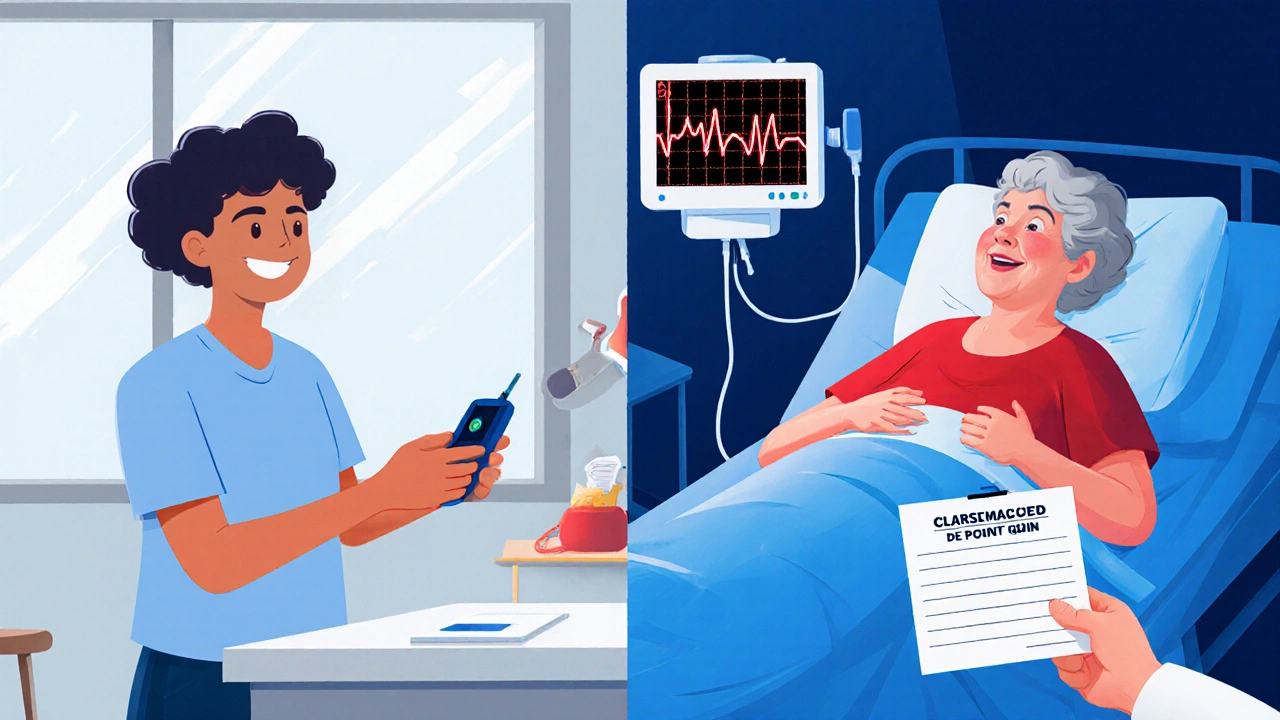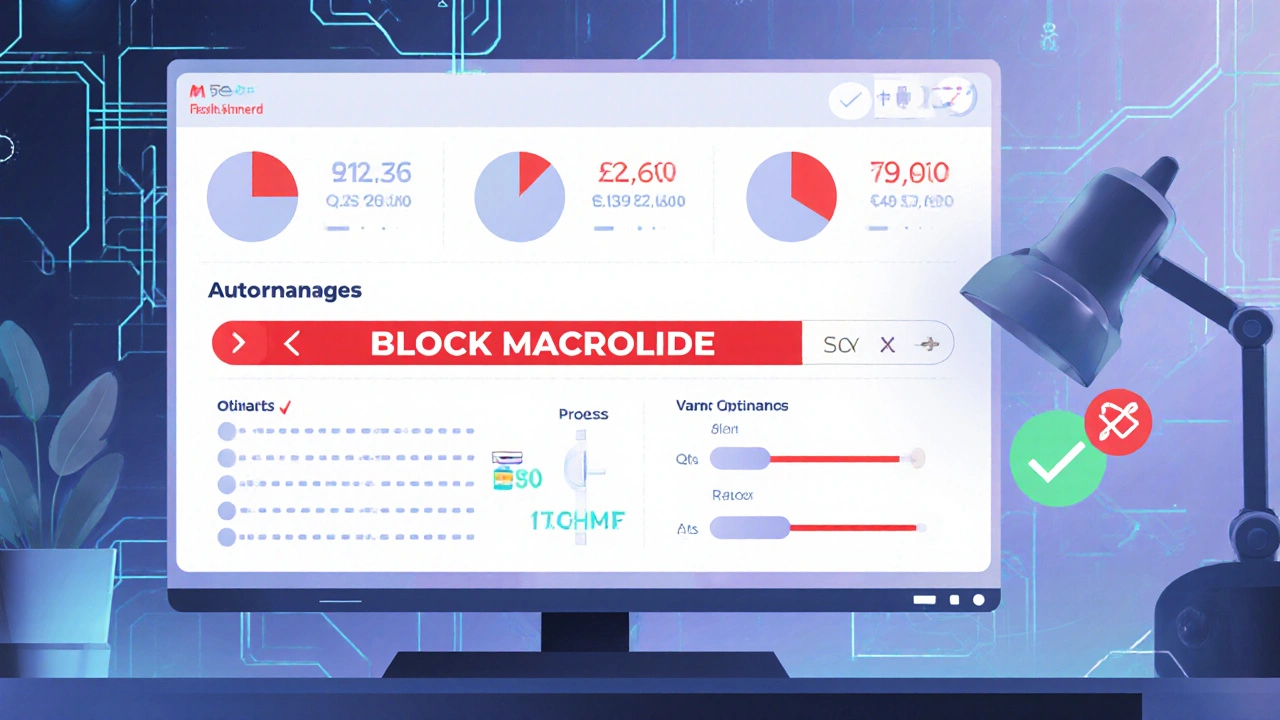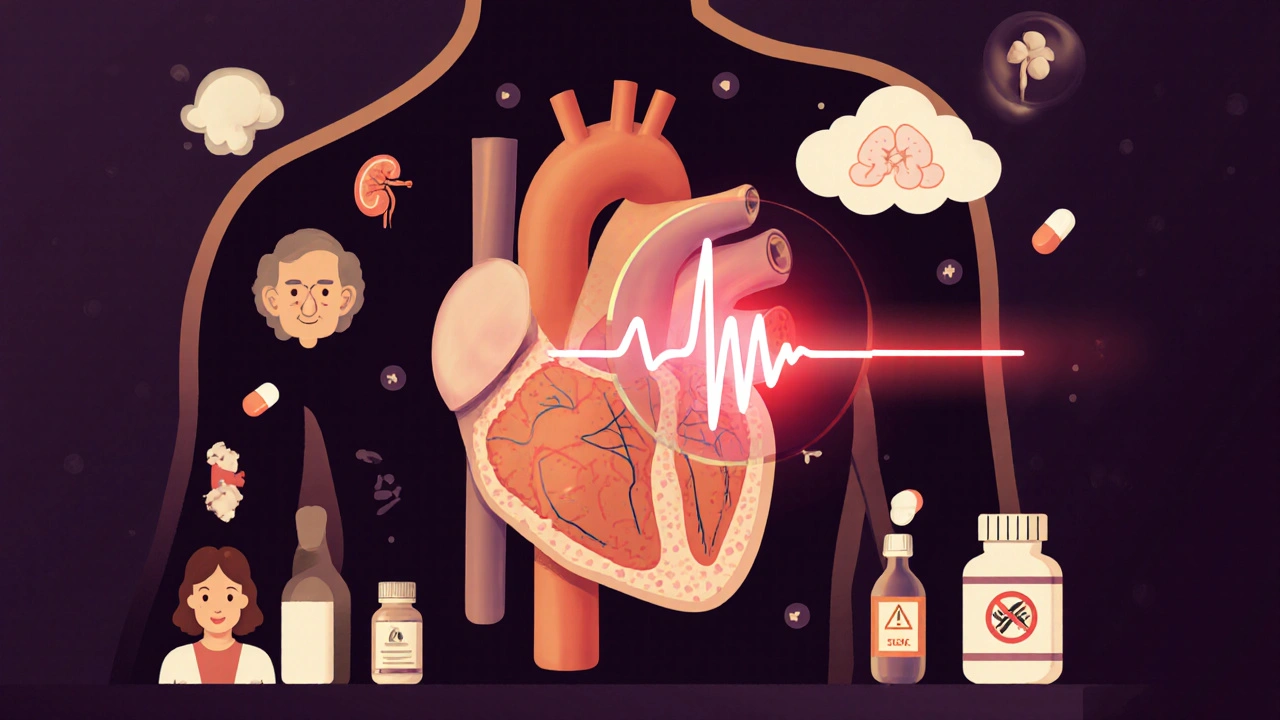Macrolide Therapy Risk Calculator
Assess Your Risk Before Starting Macrolide Therapy
This tool calculates your risk for QT interval prolongation when taking macrolide antibiotics like azithromycin or clarithromycin. Based on the latest clinical guidelines, it helps determine if an ECG is needed before starting treatment.
Risk Assessment Results
Your risk level:
Total Score: 0/8
When you’re prescribed an antibiotic like azithromycin or clarithromycin, you probably don’t think about your heart. But for some people, these common drugs can quietly disrupt the heart’s rhythm-sometimes with deadly results. Macrolide antibiotics are widely used for chest infections, sinusitis, and even long-term lung conditions like bronchiectasis. Yet behind the simplicity of a 5-day course lies a hidden cardiac risk: QT interval prolongation. This isn’t a rare side effect. It’s a well-documented, clinically significant threat that can trigger a dangerous heart rhythm called Torsades de Pointes. The question isn’t whether macrolides are dangerous-it’s who needs an ECG before taking them.
Why Macrolides Can Affect Your Heart
Macrolides like erythromycin, clarithromycin, and azithromycin work by stopping bacteria from making proteins. But they also interfere with a tiny electrical channel in your heart cells called hERG. This channel helps reset the heart’s rhythm after each beat. When it’s blocked, the heart takes longer to recharge between beats. On an ECG, that shows up as a longer QT interval. A prolonged QT isn’t just a number on a graph-it’s a warning sign. When the QT interval stretches past 500 milliseconds, the risk of sudden, chaotic heart rhythms jumps dramatically. Studies show that for every 10 ms increase beyond 500 ms, the chance of Torsades de Pointes goes up by 5-7%.Not all macrolides carry the same risk. Erythromycin is the worst offender, with a nearly five times higher chance of causing QT prolongation compared to azithromycin. But even azithromycin, the most commonly prescribed one, carries a 2.7-fold higher risk of cardiovascular death than amoxicillin, according to a major 2012 study in the New England Journal of Medicine. That’s not a small difference. It’s the kind of risk that changes how doctors think about prescribing.
Who Is at Highest Risk?
Not everyone who takes a macrolide needs an ECG. But some people are walking into danger without knowing it. The British Thoracic Society and the National Institutes of Health have identified key risk factors that make QT prolongation more likely:- Female sex (risk more than doubled)
- Age over 65
- Pre-existing heart disease or heart failure
- Low potassium or magnesium levels
- Chronic kidney disease
- Taking other QT-prolonging drugs (like certain antidepressants, antifungals, or anti-nausea meds)
- History of arrhythmias or sudden cardiac arrest
- Family history of long QT syndrome
If you have just one of these, your risk goes up. If you have three or more, you’re in the danger zone. A 2025 analysis from the NIH found that when you control for these factors, the overall risk of arrhythmia from macrolides drops to near background levels. That means the problem isn’t the drug alone-it’s the combination of the drug and the patient’s biology.
When ECG Monitoring Is Required
The British Thoracic Society made this clear in their 2020 guidelines: anyone starting long-term macrolide therapy must have a baseline ECG. That includes patients with cystic fibrosis, bronchiectasis, or chronic obstructive pulmonary disease (COPD) who need weeks or months of treatment. The cutoff? QTc over 450 ms for men, over 470 ms for women. If it’s higher, don’t start the drug. If it’s borderline, consider alternatives.But here’s the problem: most macrolides are prescribed for short-term infections-like a sinus infection or bronchitis. For those cases, guidelines are less strict. The NHS says only consider ECGs if you have risk factors. The American Heart Association’s 2025 update recommends a 9-point scoring system to calculate individual risk before prescribing. That’s the smart way forward: not blanket testing, not ignoring risk, but matching the level of caution to the level of danger.

What Happens If You Skip the ECG?
In hospital settings, ECG monitoring is common. But in primary care? It’s rare. A 2024 survey of 247 UK GPs found that 78% knew macrolides could prolong QT-but only 22% routinely ordered ECGs. Why? Time. Cost. Uncertainty. Many doctors think, “My patient is young and healthy. It’s fine.”But that’s how near-misses turn into tragedies. One Reddit user shared a case: a 68-year-old woman with a baseline QTc of 480 ms (already high) was given clarithromycin for pneumonia. Five days later, she went into Torsades de Pointes. She needed emergency cardioversion. Her ECG hadn’t been checked before the prescription. She survived. Others don’t.
Studies show that in specialized respiratory clinics where ECGs are mandatory, 92% of patients feel safer. In primary care, where screening is rare, adherence to guidelines is just 12%. That gap isn’t just a gap in care-it’s a gap in safety.
The Cost of Screening vs. The Cost of Not Screening
Some argue that screening everyone is too expensive. In the UK, each ECG costs about £28.50. With 12 million macrolide prescriptions a year, universal screening would cost £342 million. That sounds outrageous.But consider the alternative. A single case of Torsades de Pointes can cost over £20,000 in emergency care, ICU stay, and long-term monitoring. The Institute for Clinical and Economic Review estimates that targeted ECG screening in high-risk patients could save the U.S. healthcare system $217 million a year by preventing complications. That’s not just money-it’s lives. And it’s not just about cost. It’s about avoiding irreversible damage.

What Should You Do?
If you’re prescribed a macrolide, here’s what to ask:- Do I have any risk factors for long QT syndrome?
- Have I had an ECG in the last 6 months?
- Am I taking any other drugs that can affect my heart rhythm?
- Is this a short-term or long-term course?
- Can we check my QT interval before I start?
If you’re over 65, female, on other medications, or have heart or kidney disease-push for the ECG. It’s a 5-minute test that could save your life. If you’re young and healthy with no other meds and no history of heart issues, the risk is low. But don’t assume. Ask.
What’s Changing in 2025?
Technology is catching up. The British Thoracic Society is testing handheld ECG devices in 15 UK clinics that give results in under 10 minutes. No more waiting days for a hospital appointment. In the U.S., Epic’s electronic health record system now automatically flags macrolide prescriptions for patients with high QT risk. That’s a game-changer. It means the system, not just the doctor, is watching out for you.And the science is getting smarter. The 2025 NIH algorithm doesn’t just look at QTc. It weighs age, sex, kidney function, drug interactions, and electrolytes together. It’s not a yes-or-no rule-it’s a risk score. That’s the future: personalized safety, not one-size-fits-all screening.
Final Thoughts
Macrolides are not dangerous drugs. They’re lifesavers for millions. But like any tool, they need to be used with care. The data is clear: ECG monitoring isn’t about fear-it’s about precision. You don’t need to screen everyone. But you absolutely need to screen those at risk.If you’re a patient: know your risk. Ask for an ECG if you’re unsure. If you’re a clinician: don’t assume. Don’t skip the test because it’s inconvenient. The cost of doing nothing is far higher than the cost of doing it right.
Do all macrolide antibiotics carry the same risk of QT prolongation?
No. Erythromycin has the highest risk, followed by clarithromycin. Azithromycin carries a lower but still significant risk. Studies show erythromycin is nearly five times more likely to cause QT prolongation than azithromycin. The risk isn’t just about the drug class-it’s about the specific molecule and how it interacts with the heart’s potassium channels.
Can I take azithromycin if I have a slightly prolonged QT interval?
If your QTc is between 450-470 ms (the upper limit for men and women), doctors may still prescribe azithromycin-but only if the benefits clearly outweigh the risks. If your QTc is above 470 ms for women or 450 ms for men, guidelines recommend avoiding macrolides entirely. Alternative antibiotics like amoxicillin or doxycycline are safer options. Never ignore a borderline QT result.
How long should I wait after stopping a macrolide before getting an ECG?
If you’ve taken a macrolide and are concerned about QT prolongation, an ECG should be done within 48 hours after stopping the drug. The effect can last for several days, especially with longer-acting macrolides like azithromycin. Don’t wait until symptoms appear-by then, it may be too late. If you’re on long-term therapy, repeat ECGs at one month are recommended to catch delayed changes.
Are there alternatives to macrolides for people at risk of QT prolongation?
Yes. For respiratory infections, amoxicillin, doxycycline, or cefdinir are common alternatives with no QT risk. For chronic lung conditions like bronchiectasis, non-antibiotic options like inhaled corticosteroids or mucolytics may be used alongside safer antibiotics. Always discuss alternatives with your doctor-especially if you have multiple risk factors.
Can a normal ECG guarantee I’m safe to take a macrolide?
No. A normal ECG reduces risk but doesn’t eliminate it. QT prolongation can develop after starting the drug, especially if you’re also taking other medications or have low potassium. That’s why repeat ECGs are recommended for long-term use. Also, some people have hidden genetic forms of long QT syndrome that don’t show up until triggered by a drug. Always monitor for symptoms like dizziness, palpitations, or fainting after starting any new medication.
Why don’t all doctors order ECGs before prescribing macrolides?
Time, cost, and lack of clear guidelines for short-term use are the main reasons. Many doctors believe the risk is too low in healthy patients to justify screening. But studies show that in primary care, where most macrolides are prescribed, adherence to safety guidelines is under 15%. This gap exists not because doctors are careless, but because the system doesn’t make it easy to do the right thing. Electronic alerts and point-of-care ECGs are helping close that gap.


Katy Bell
November 22, 2025 AT 04:35Just got prescribed azithromycin for my sinus infection and I’m 67, on lisinopril, and my potassium’s been low lately. I asked my doc for an ECG before filling it-she looked at me like I asked for a unicorn. Guess I’m the weird one now. 😅
JD Mette
November 23, 2025 AT 18:58It’s wild how something so common can carry such a quiet danger. I’ve had two family members on long-term macrolides for COPD-neither had an ECG. One’s fine. The other had a near-miss. It’s not fear, it’s just… awareness. We need better systems, not just better patients.
Olanrewaju Jeph
November 23, 2025 AT 21:45As a physician in Lagos, I can confirm that this issue is grossly underrecognized in low-resource settings. ECG machines are rare, and antibiotics are dispensed like candy. We rely on clinical judgment-but when the patient is elderly, female, and on diuretics, the risk is real. No one is teaching this in med school here. Someone needs to write a pocket guide.
Dalton Adams
November 24, 2025 AT 18:22Let’s be real-this isn’t even controversial. The NEJM paper from 2012 is a slam dunk. Azithromycin’s relative risk of cardiovascular death is 2.7x higher than amoxicillin? That’s not a whisper, that’s a scream. And yet, primary care docs still treat it like a harmless decongestant. I’ve seen it: 72-year-old woman with CKD stage 3, on amiodarone, prescribed clarithromycin for bronchitis. No ECG. No review of meds. No alarm bells. This isn’t negligence-it’s systemic ignorance wrapped in a white coat. The 2025 NIH algorithm? It’s not fancy-it’s basic math. Why are we still debating this? 🤦♂️
Jennifer Shannon
November 25, 2025 AT 16:19You know, I’ve been thinking about this like a puzzle-each risk factor is a piece, and the drug is the final slot. If you put it in without checking the rest of the board, the whole thing might collapse. I’m not a doctor, but I’ve watched my mom navigate the system for years-she’s 71, diabetic, on a diuretic, and takes omeprazole. When she got azithromycin last year, I insisted on the ECG. The tech said, ‘Oh, you’re the first person this week to ask.’ That’s the problem. We’ve normalized risk. We’ve made ‘it’s probably fine’ into a medical protocol. But hearts don’t care about convenience. They don’t care if the clinic is busy. They just beat-or they don’t. And sometimes, all it takes is five minutes and a $28 test to keep them going.
Suzan Wanjiru
November 27, 2025 AT 13:14My aunt had torsades after clarithromycin. She didn’t even know what QT meant. She just took the script. Now she’s got a pacemaker. Don’t wait for symptoms. If you’re over 60, on meds, or female-ask. It’s not pushy. It’s smart. And if your doc says no? Get a second opinion. Your life isn’t a gamble.
Kezia Katherine Lewis
November 29, 2025 AT 04:43From a pharmacovigilance standpoint, the hERG channel blockade is a well-characterized off-target effect. The pharmacokinetic profile of macrolides-particularly azithromycin’s long half-life and tissue accumulation-exacerbates the risk profile in polypharmacy populations. The absence of routine ECG monitoring in primary care represents a critical gap in risk stratification protocols, particularly in cohorts exhibiting polypharmacy, electrolyte derangements, and comorbid cardiac or renal pathology. The 2025 NIH algorithm represents a paradigm shift toward dynamic, multivariate risk assessment rather than binary, static screening.
Henrik Stacke
November 30, 2025 AT 11:55It’s a bit heartbreaking, isn’t it? We’ve got the tools, the data, even the guidelines-and yet, the system still lets people slip through. I work in a London GP practice. We’ve started using the NHS risk calculator on our EHR. It’s not perfect, but it’s a nudge. One of my patients-a 69-year-old woman with mild CKD-was about to get clarithromycin. The system flagged her. We switched to doxycycline. She thanked me. Said she didn’t even know she was at risk. That’s the win. Not the ECG. The conversation.
Kane Ren
December 1, 2025 AT 02:21Hey, if you’re young, healthy, and taking azithromycin for a cold-don’t stress. But if you’re on anything else? Check your meds. I used to think this was overblown-until my buddy’s dad went into cardiac arrest after a Z-pack. He was 61, on a statin, and had borderline HTN. No one asked. No one checked. Now he’s fine, but he’s got a new respect for the word ‘risk.’
John Mackaill
December 1, 2025 AT 03:16That Reddit story about the 68-year-old woman? That’s the one that sticks with me. Not because it’s rare-but because it’s preventable. And that’s the real tragedy. We don’t need more research. We need better habits. A quick ECG isn’t a burden-it’s a courtesy to your own body. And if your doctor won’t do it? Find one who will.
Jennifer Skolney
December 1, 2025 AT 18:15My mom’s 70, has COPD, and just started long-term azithromycin. We got the ECG before she took the first pill. She’s fine now. But I told her: ‘If they ever say ‘it’s fine’ again, you say ‘I’d rather be safe than sorry.’’ And she did. 😊